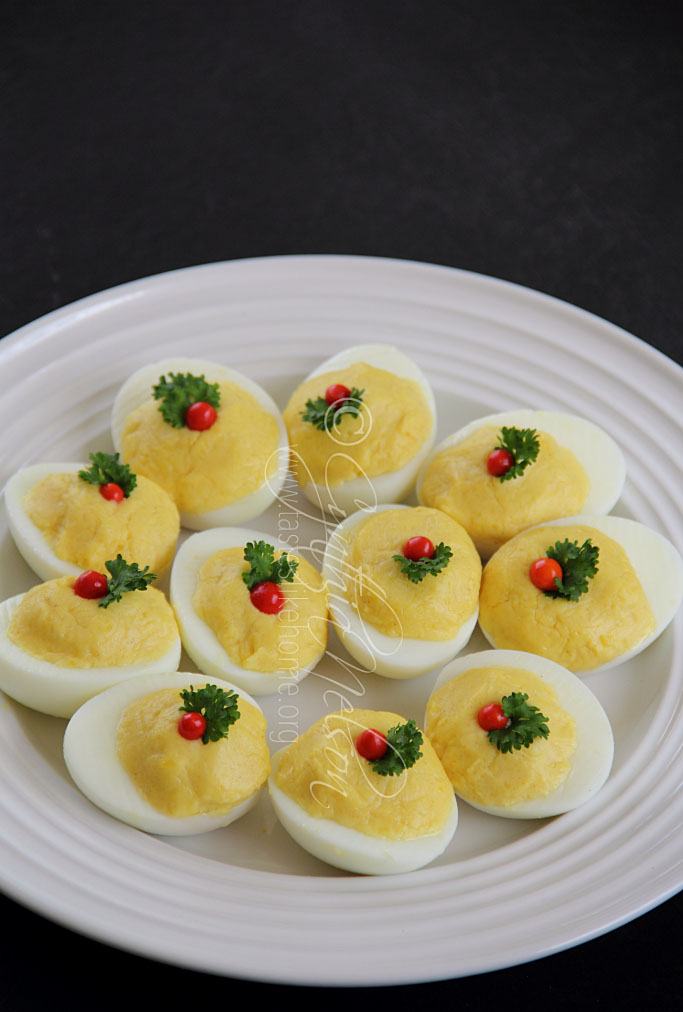
Imagine this – pretty, little, white oval shapes of eggs stuffed with mounds of cheesy filling, richly yellow from the mustard, adorned with a sprig of parsley and dotted with a wiri wiri pepper. I love Stuffed Eggs and while they can be filled with just about anything, I prefer the filling to be simple – yolks, cheese, mayo, and mustard rounded out with a hint of pepper sauce and a pinch of salt.
Whether the tea gathering was at Sacred Heart Church or at home, my sister Pat and I always enjoyed helping out by making the Stuffed Eggs. Our reward was always that wayward egg or two that would not peel so perfectly and therefore could not make it to the prized platters of perfection. And invariably, there was always a little filling left over that we would use to make a couple of sandwiches for ourselves. So many little sunshine memories associated with stuffed eggs.
Pat and I would work like an assembly line. Together we’d peel the eggs. Then one of us would halve the eggs while the other removed the yolks. I’d make the filling while she would carefully select and pluck the leaves of parsley. The peppers had to be uniform in size. With the filling mixed. I would stuff the eggs and she would garnish them. We’d stand back and admire our work. We worked well together. I miss my sister.
Are you making Stuffed Eggs for your tea gathering this weekend? They are easy to make. Here are a few pointers to consider.
The eggs
Many people say that stale eggs make the best Devilled Eggs because when boiled they are easier to peel. Honestly, I have found that it doesn’t matter, but go with what you prefer. Stale eggs are eggs that are more than 9 days old.
Remove the eggs from the refrigerator and bring them up to room temperature before boiling them. If you put the eggs to boil straight from the fridge, you run the risk of the eggs cracking because of the shock from cold to heat. You also may end up with rubbery, overcooked egg whites and yolks that are not fully cooked.
Add the eggs to a large pot so that they have adequate space to move as they boil and not bump into each other. Cover the eggs with water. Add a little salt to the water if you like (salt raises the temperature of boiling water) and it also seasons the whites a little (eggshells are porous). Now everyone has their own formula for boiling eggs. My method is to bring the eggs to a boil on medium high heat and cook them for exactly 6 minutes.
It is not necessary that the yolks be centred for devilled eggs but if you want to be fussy about it, here are two things you can do – store the eggs point side down or store them on their side for at least 8 hours before cooking them.
Avoiding the grey sulphur ring
Whether you are making stuffed eggs or boiling eggs for any other preparation, you want to avoid the egg developing the grey sulphur ring. To do this, immediately remove the eggs with a slotted spoon when they are done cooking and place them in a large bowl of ice-cold water. This stops the cooking process and
prevents sulphur from developing. Sulphur rings around the yolks develop as a result of prolonged cooking of the eggs. Let the eggs cool down for 5 to 6 minutes before you crack, roll, and start peeling the eggs.
Here’s a tip if you want to have boiled eggs for a few days: as soon as you remove the eggs from the cold water, pat them dry and refrigerate them in their shells until you are ready to use them. They will last up to a week.
The stuffing
When cutting the eggs in half, do not use a sawing motion, use a sharp knife, and make a straight cut. Clean the knife of any yolk remnants as you slice through the eggs. This will avoid any flecks of yolk getting stuck on the edges of the egg whites.
There are many recipes that advise that all the ingredients for the filling be mixed together at one time, and you can do that. I don’t. The yolks really need to be mashed well, first, then I add the cheese (I have found that nothing beats a sturdy fork for this phase of the mashing-mixing). I switch to a flat rubber spatula after I’ve added the other ingredients. This is a situation where I want you to use which tool you feel most comfortable with to do this task. Remember your aim is for a creamy filling.
The filling should not be runny; it should be firm but soft enough to be piped into the egg whites or filled using a spoon.
Garnishing
I garnish with a sprig of parsley and wiri wiri pepper; it’s what my Mother did. I always let people know that the pepper, though edible, is hot and is only there for garnishing. Some brave people have been known to pop the entire thing into their mouth – pepper and all. I have.
Storing and serving
Once stuffed, cover the eggs, and refrigerate, or, serve immediately. If you are planning on serving the eggs later the same day or the next day, you can opt to garnish just before serving.
If the stuffed eggs were refrigerated, they can be served chilled but I think they are better when brought up to room temperature; the flavours of the filling are tastier.
Happy Easter!
Cynthia






